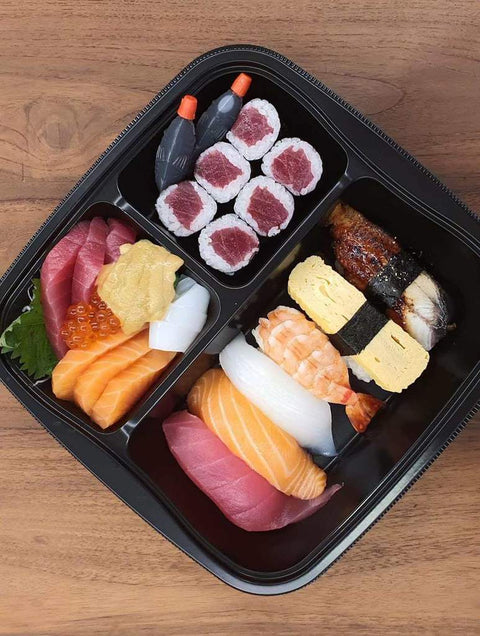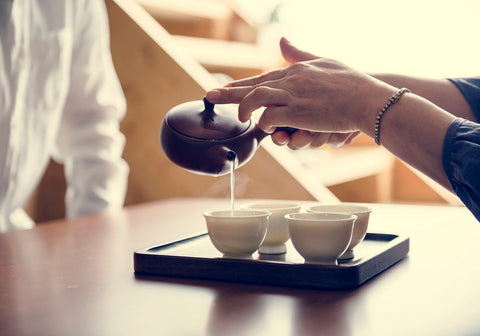How should I make my sake food pairings?
- By Body
- Light-Bodied Sake
- Medium-Bodied Sake
- Full-Bodied Sake
Do you love food? Do you love sake? Are you confused about how to pair these two amazing things together? Don’t worry, you’re not alone. Sake can be quite an intimidating drink — even for those who have tried it before. After all, it’s a complex drink, so it’s easy to assume that pairing would be complex as well. However, food pairings for sake are more simple than you would expect. In fact, there are several ways to pair your drink successfully. If you are ready to learn more, keep reading.
By Body

When you are first trying to figure out what type of sake to pair with your food, and vice-versa, the main goal should be to achieve balance. And to do that, you have to understand the differences between sake bodies, and how that affects your pairing.
This science is quite similar to pairing wines. Generally, light dishes are best with smooth, clean drinks. The same goes for richer cuisine. If you are eating a salty dish, you’d need some dryness to balance it out. With matchings such as these, you can achieve a state of equilibrium among the flavors of the food and sake.
Another thing to look for is harmony. The key to making a harmonious pairing is to pay attention to the sake’s finish. A crisp finish or a shorter length ensures your drink won’t get in the way of what it’s paired with.
Regardless of where you are in your pairing journey, always pay attention to the type of sake you’re drinking. This is a great indicator of what kind of taste, body, texture, and aroma they have — which will help you find the perfect pairing.
Light-Bodied Sake
Light-Bodied Sakes, like Namasake, Ginjo, and Daiginjo options, typically have a lighter body and feel than others. As such, they go well with simple and light dishes.
Take Namasake, for example. With medium dryness, smooth mouthfeel, and a light and pleasant fruit-forward fragrance, they have a freshness that’s similar to white wine. We suggest enjoying your Namasake with some fresh seafood dishes, such as salmon sashimi, fresh oyster, or fish with broth. Any dish lightly seasoned with ponzu or soy sauce brings an umami kick that pairs well with the freshness of Namasake.
On the other hand, Ginjo and Daiginjo Sake are other light-bodied options that have a light yet dry body, and a pleasant flowery and fruity aroma. This type of sake normally features a fragrant, complex taste that makes it go well with simple dishes. We advise against pairing with heavy or oily dishes, as their lighter and softer flavors become overpowered in this case.
We do recommend pairing it with steamed or raw foods, light vegetable dishes, as well as salads. Our top recommendation is having your Ginjo and Daiginjo sake with a Koji Box from Sake Society. With its wide selection of sushi and sashimi, you’ll have many options to enjoy that all marry perfectly with the subtler tastes of your sake.
Medium-Bodied Sake
Medium-bodied sake like Honjozo and Futsushu Sake generally have a heavier, earthier flavor than light-bodied sake. So, these go well with medium-flavored dishes (think salted and grilled food). And while Futsushi and Honjozo sake have less complex tastes compared to other sakes, their balanced body makes them easy to drink and appealing to most.
Honjozo sake is light and dry, earthy yet quite fragrant. On the other hand, Futsushu makes up about 80% of the sake market, and there are few rules as to how they should be made, but they typically end up with subdued flavors and little to no acidity.
Futsushu is relatively straightforward — it has a medium body and milder taste, so you can pair it with virtually any cuisine or dish you can think of. For Honjozo’s earthier flavors, we recommend pairing it with grilled meats, from steaks and burgers to chicken breasts, as well as grilled or sautéed veggies and kebabs.
Full-Bodied Sake
Full-bodied sake pairs very well with fatty, sauce-heavy dishes, as the sake’s taste doesn’t get overpowered. One good full-bodied sake to try is Junmai sake. They’re characterized by an intense and full body, a hard and crisp texture, higher acidity, and a ripe aroma. The main feature of Junmai sake is the strong taste of rice. Due to these qualities, we highly recommend your pairing should be somewhat similar — like a rice-based dish featuring heavy seasoning.
You can also pair this sake with seasoned dishes, such as yakitori, lobster salad, marinated salmon, and the like. It also goes great with high umami veggies like mushrooms, asparagus, and artichokes. You can also enjoy this sake with chicken teriyaki, miso oden, barbequed meats, pork belly dishes, and deep-fried foods.
Key Takeaway
To sum it up, lighter flavor dishes pair well with light sakes, while savory dishes tend to do well with bolder styles of sake. We highly encourage you to try different styles and explore new sake and food pairings — it’s the best way to discover more about this drink. So, choose a bottle from Ralph’s Wines & Spirits’ sake collection, and order up some dishes following our guide. Enjoy!



